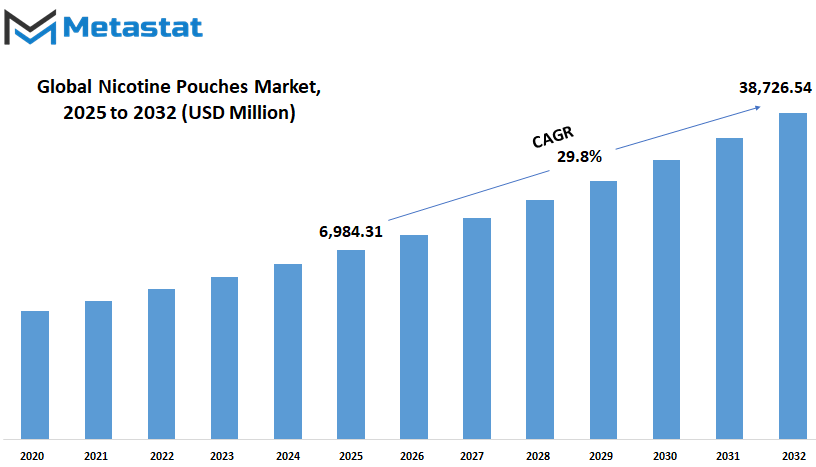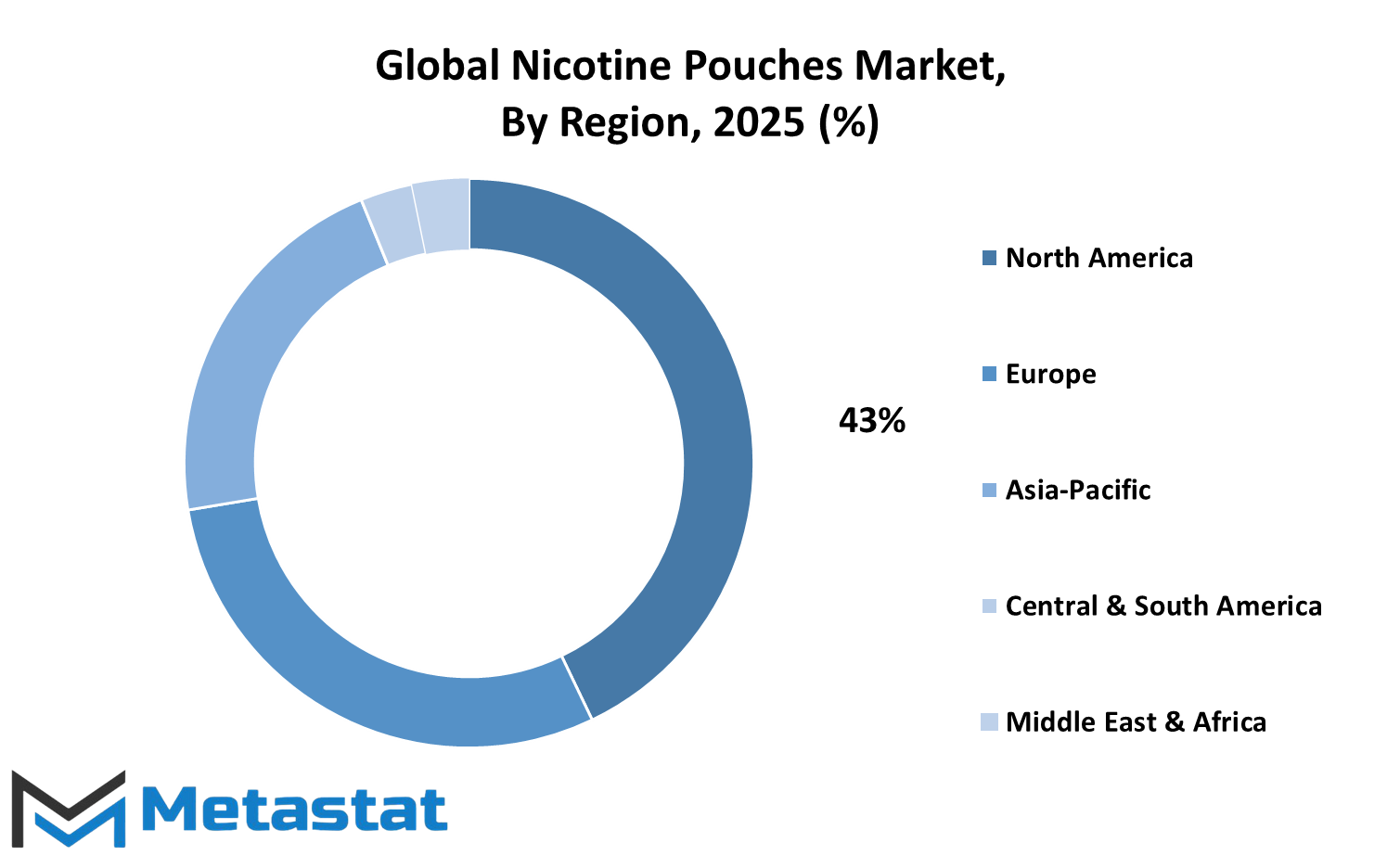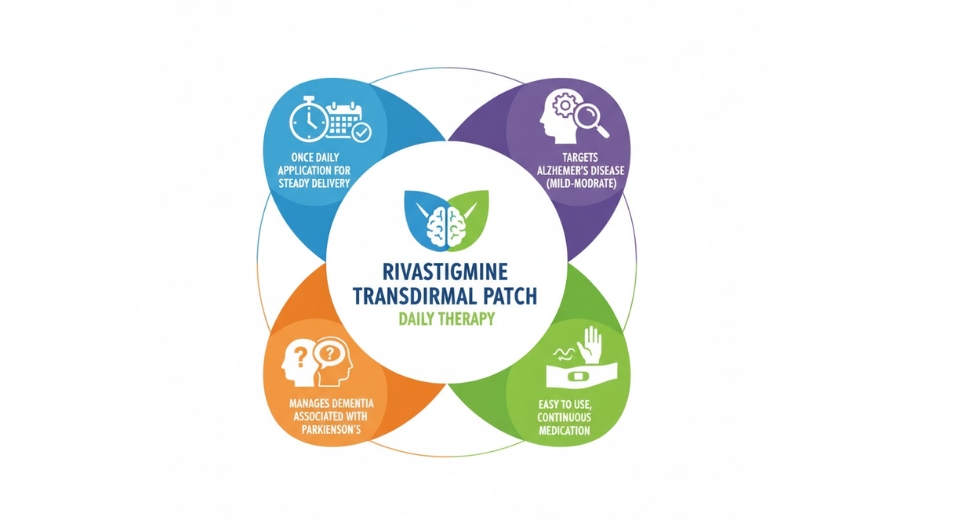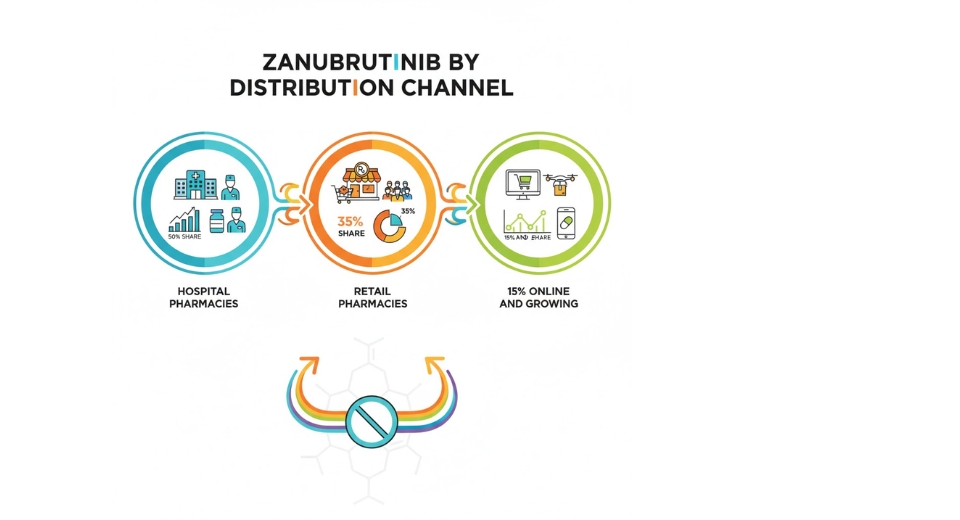MARKET OVERVIEW
The global nicotine pouches market, which is part of the wider smokeless tobacco and alternative nicotine delivery systems sector, will be a niche segment that addresses oral products delivering nicotine without tobacco leaf. The pouches, usually positioned between the lip and gum, will employ plant fibers treated with pharmaceutical-grade nicotine, flavorants, and stabilizers to provide a smokeless and inconspicuous experience for the consumer. The market will keep evolving as the regulatory scenarios change and demand for tobacco-free nicotine products increases. In contrast to conventional tobacco products, nicotine pouches will not depend on inhalation or combustion, which will make them a substitute for both vapor-based systems and cigarettes.
This feature will influence not just their user attractiveness but also how they are regulated across different markets. The global nicotine pouches market will span both high-income and low-income economies, though uptake patterns will differ by public health policy, cultural attitude toward nicotine, and consumer familiarity with harm-reduction products. Producers in this category will concentrate on improving formulation science, attaining consistency of nicotine release, and diversifying flavor portfolios appealing to different demographic groups. Pouches will be available in different strengths to suit various user needs, from users who want a low-dose supplement to others who prefer a stronger, quicker-acting sensation.
The product design will be focused on ease of use, oral comfort, and long shelf life, all of which will be major characteristics in product differentiation. global nicotine pouches market distribution strategies will become increasingly fragmented in the future. Both established players and individual producers will invest in a variety of retail channels such as convenience stores, specialty stores, and online. Regulatory forces will put pressure on packaging, advertising, and product location, particularly in areas where nicotine products are subject to strict public health regulations.
Every market will create its own legal definitions, limitations on use, and thresholds for compliance, making international expansion a strategic headache. Its competitive environment will be marked both by established tobacco companies shifting toward nicotine alternatives and new players exclusively dedicated to this tobacco-free market. Both the coexistence will challenge the limits of innovation and the urge to meet expectations of public safety as well as consumer happiness. Retail partnerships and online platforms will also contribute significantly to brand awareness and consumer education. Cultural influences will determine the rate and style of adoption, and Northern and Western Europe will probably continue to lead in setting consumer standards and regulatory norms. Being ahead on smokeless nicotine products already, these two areas will set standards for product development worldwide. Other areas will advance at varying speeds based on infrastructure, sentiment, and policy regimes. The global nicotine pouches market will not exist independently but will engage in close interaction with neighboring industries such as pharmaceuticals, health and wellness, and public health. It will continue to evolve in accordance with innovation, changing the law and changing consumer values, eventually writing a new chapter in the way nicotine is consumed within a contemporary, health-aware society.
Global nicotine pouches market is estimated to reach $38,726.54 Million by 2032; growing at a CAGR of 29.8% from 2025 to 2032.

GROWTH FACTORS
The global nicotine pouches market is projected to expand robustly in the forthcoming years as more and more consumers opt for tobacco-free products to consume nicotine. This is not a temporary trend but rather indicative of growing health and wellness awareness. Large numbers of consumers are now actively seeking substitutes that are considered less risky than the conventional tobacco product. The fact that nicotine pouches can be ingested without burning or inhaling gives them a head start, especially for those looking to move away from smoking or tobacco. The heightened awareness regarding the health effects of smoking ranks among the most important reasons for such a shift. More and more consumers are turning to products that allow them to manage their nicotine consumption without exposing themselves to the known dangers of tobacco.
Nicotine pouches are seen as cleaner, and they are proving to be more popular with people who are particular about what they eat. They have the extra advantage of being smoked secretly, without producing smoke or odor, thereby being ideal to use in many different places, even where it is not allowed to smoke. Convenience also is contributing a major role in increased demand. Being able to carry and consume nicotine pouches without notice is alluring to most consumers, especially those with hectic schedules. This portability and convenience factor lends credence to the growing demand for on-the-move nicotine products. With increasing numbers of consumers looking for products that can be incorporated into their lifestyle, such products are likely to be increasingly popular. Although there is encouraging potential, there are some concerns still lingering that may inhibit the growth rate. Regulations on nicotine products are extremely different in one location to another, and others have fuzzy or constantly changing rules.
This creates uncertainty for manufacturers and sellers, which makes it challenging to plan for expansion or invest in new markets. In addition, apprehension about long-term negative health effects and the lack of comprehensive testing might discourage some people from widespread adoption of the product.
Regardless of these challenges, there are still many opportunities ahead. Brands which focus on innovation, having increased flavors and nicotine levels, will try to attract new smokers and penetrate untapped markets. With the changing tastes of the consumers, companies that will be agile with their action will likely perform better in the global nicotine pouches market in the next several years.
MARKET SEGMENTATION
By Product Type
The global nicotine pouches market is slowly evolving into a major segment of the larger tobacco alternatives category. As individuals increasingly seek alternatives that may lower harm or provide a unique experience compared to smoking, nicotine pouches have established a rising user base. The small, discreetly placed pouches under the lip offer a smokeless and frequently odorless means to consume nicotine. As opposed to conventional tobacco products, they are not needed to be combusted, hence appealing to those interested in eliminating the hazard associated with smoking. What makes them unique is the fact that they don't contain tobacco leaf but only nicotine, which may be extracted from tobacco leaves or developed in the laboratory. On the basis of product type, the global nicotine pouches market is divided into tobacco-based nicotine and synthetic nicotine.
The first form continues to utilize nicotine extracted from the tobacco plant but omits the actual tobacco substance. This may be attractive to consumers who prefer to retain the familiar sensation of tobacco products without taking the toxic byproducts. Synthetic nicotine, in contrast, is produced without even utilizing the tobacco plant. With lab-grown nicotine becoming increasingly pure, it could provide manufacturers and consumers alike a degree of control and purity that is attractive. Synthetic alternatives are viewed by many as a step in the direction of more controlled and potentially safer product, particularly as consumer demand increases for cleaner and more transparent ingredients in consumer products. Looking toward the future, the global nicotine pouches market is expected to change in both how products are made and how people use them. As more research is done and new technology becomes available, the way nicotine is delivered will likely become even more tailored to individual preferences.
User safety, convenience, and personal taste will continue to shape product development. Regulations will also likely change as governments and public health organizations react to the increasing popularity of these products. As this market continues to evolve, firms will need to remain adaptable and responsive to changes in both consumer habits and formal advice. With these trends, the global nicotine pouches market will become increasingly complex, yet more organized. The dichotomy between tobacco-based and synthesized nicotine reflects how businesses are venturing down new avenues. Both directions have their own appeal, and future expansion will rely on how well both forms satisfy various consumers.
By Flavour
The global nicotine pouches market is anticipated to grow steadily with increasing individuals seeking tobacco-free alternatives. The pouches are little, white packets that hold nicotine but no tobacco leaves. They are usually inserted between the gum and lip, providing a spit-free and smokeless experience. As education regarding health hazards from smoking keeps spreading, the majority of consumers are opting for products such as these that provide them with the nicotine they desire without the chemicals in conventional tobacco. This change in taste is slowly altering the market trend, compelling manufacturers to develop new and innovative product alternatives. Flavor is one key driver that will shape future trends.
The global nicotine pouches market is now defined by options like Original or Unflavored, Mint, Fruit, coffee, Cinnamon, and a variety of other options of these, Mint is still one of the most popular, with its clean and fresh flavor. Fruit flavors also appeal to users who desire something sweeter or more fun. Coffee and Cinnamon options are even bolder, usually being chosen by users seeking stronger or more distinct options. As the market expands, businesses will seek to introduce even more flavors, attempting to entice young adult consumers without alienating long-time clients. Flavors are essential to user satisfaction, and the future of the global nicotine pouches market will most certainly include an increase in personalized options. Businesses may provide an option for users to combine flavors or choose nicotine levels dependent on their individual requirements.
This type of personalization can be used to boost loyalty and attract inquisitive first-time customers. It also provides a means for innovation in packaging and delivery formats that can further distinguish a brand. A second area to watch is how regulatory policies and public health campaigns will affect the market. Some nations might restrict some flavors based on fears about being attractive to youthful consumers, while others will give manufacturers a lot of freedom in creating products. The businesses that will thrive are those who recognize these boundaries yet still develop attractive, responsible products. Through the next few years, the global nicotine pouches market will be influenced by user demand as well as wise regulation. Interest will be fueled by flavor diversity, convenience, and health-conscious options. Through continued research and product development, this market will continue to evolve to meet consumer needs, making nicotine less harmful and easier to access for adults looking for a replacement for smoking.
By Strength
The global nicotine pouches market will remain in the limelight as individuals look for alternatives to conventional tobacco. In the wake of growing consciousness about health, users are increasingly opting for products that have no need for smoking or chewing tobacco leaves. Nicotine pouches provide a spit-free and smoke-free mode of consumption, something that a broad category of consumers seek out with convenience without many of the ill effects of cigarettes or chewing tobacco. The market will expand not only based on a change in behavior, but also based on product diversity and how manufacturers react to consumer demand. One key way this market is segmented is by strength.
Individuals have varying nicotine levels they prefer, and hence there are distinct categorizations light, normal, strong, and extra strong. New nicotine users or those attempting to quit will usually start with milder ones. Such pouches contain less nicotine content and provide the user with greater control of the amount consumed. For experienced users, strong or extra strong products could be preferable. These provide a higher strength and can be a way for long-term users to get satisfied without needing to use a multiple-pouch system. Firms within this industry will have to utilize these strength divisions as a means to better serve demand. We will see more and more brands introducing additional strength offerings in the future to provide users with a larger range of options.
They could also mix strength with other aspects like taste, pouch size, or even rate of the nicotine release. As more competition arises, manufacturers will attempt to perfect their product in order to differentiate themselves and retain customers. How people buy these products is also shifting. Online retailers make it easy to compare and select precisely what one desires. As world shipping gets quicker and simpler, consumers around the globe will be able to access more brands and flavors of nicotine pouches than ever before.
Marketing will be driven more by personalization, where users can choose by habit and objective. Gone are the days of a one-product-fits-all model; instead, we will have by-mood, by-time-of-day, or by-level-of-use options. The global nicotine pouches market will continue to grow steadily as companies and consumers transition to safer, more convenient methods of consuming nicotine. With an emphasis on strength and convenience of use, this market will remain vibrant and poised for emerging demands.
By Distribution Channel
The global nicotine pouches market is exhibiting signs of stable growth and is expected to further develop in the years to come. With individuals seeking alternatives to conventional tobacco, nicotine pouches are being recognized as a cleaner and frequently more socially approved choice. This change in consumer trends is influencing the distribution of the products and the way in which they are marketed. Every distribution channel does its bit to bring the product to the people who desire it, and how this is done will probably continue to evolve over time. E-commerce websites are gaining popularity because customers like the ease of shopping at home.
With a click or two, customers can browse through many brands and flavors, check out what others say about them, and get their pick delivered at home. This method is not just easy but also provides users with the ability to shop anonymously, which can be important when buying things such as nicotine pouches. As technology continues to improve and speed up, the process of buying online will become increasingly more convenient and user-friendly, which may serve to further promote this method of sales. Company-run websites are significant as well. They enable brands to decide how their products are represented and sold, usually with discounts or product information not available from other sites.
They can establish trust by providing consumers with a direct link to the producer. In the near future, companies may include features such as personalized recommendations or membership plans, enabling them to engage more closely with repeat customers. Conversely, a large number of people still appreciate the process of shopping in person. Retail outlets such as supermarkets and hypermarkets allow them to physically see the product. Consumers are able to compare the various possibilities, even seek advice from workers on occasion, and leave with the item in question immediately. These big stores will remain relevant, particularly in markets where internet-based shopping is less frequent or not trusted.
Convenience stores and drug stores make it easy and quick to buy, particularly for those who already go there for other everyday essentials. Being smaller often results in fewer options, but for a person who does have something in mind, this can be an easy and quick method of restocking. As times change, these types of stores may stock more to respond to evolving needs.
All these methods of selling nicotine pouches will define the future of the global nicotine pouches market, with each one providing a unique experience suitable for different types of consumers.
|
Report Coverage |
Details |
|
Forecast Period |
2025-2032 |
|
Market Size in 2025 |
$6,984.31 million |
|
Market Size by 2032 |
$38,726.54 Million |
|
Growth Rate from 2025 to 2032 |
29.8% |
|
Base Year |
2024 |
|
Regions Covered |
North America, Europe, Asia-Pacific Green, South America, Middle East & Africa |
REGIONAL ANALYSIS
The global nicotine pouches market is steadily transforming the manner in which individuals worldwide address smoking alternatives. This is brought not just by increasing health consciousness but also by local tastes and evolving lifestyles. With individuals starting to seek smokeless alternatives, nicotine pouches have already begun receiving more visibility. The small, tobacco-free packets are viewed by many as a cleaner and less conspicuous means of ingesting nicotine. They provide convenience, with no combustion required, which is attractive to users who desire a lower-risk alternative than conventional tobacco products. In the future, this market will continue to grow. Consumers are better educated on health now, and that trend is likely to keep going. With governments advocating for lower smoking levels and businesses investing in alternatives, nicotine pouches are perfectly poised to become a standard fixture in the dialogue. Their destiny will not only ride on product supply but also on the acceptance and adaptation of each market to this new alternative. Geography is a significant driver in determining the future of the Global Nicotine Pouches industry.
In the North American region, the U.S. has experienced an increase in demand, and that trend is expected to spill over to Canada and Mexico. The region is already well-entrenched with consumers receptive to smokeless products. Europe, particularly nations such as the UK, Germany, France, and Italy, has been interested because of a combination of public health initiatives and cultural transition to alternative nicotine products. Since regulations and attitudes differ, the rest of Europe will most probably experience uneven growth based on policies at the national level. Asia-Pacific region is one where there is heterogeneity, and high population and growing disposable income can propel significant growth in economies like India, China, Japan, and South Korea. Interest in less conventional nicotine products is growing, and thus it will influence demand in the long term.
South America, and Brazil and Argentina in particular, will take time to embrace these products at large levels, but there is increasing interest. Lastly, in the Middle East & Africa, nations like the GCC states, Egypt, and South Africa will be central as awareness and availability grow. As the market grows, every region will have its own rhythm and tempo of expansion. Given a global emphasis on health and personal decision, nicotine pouches will increasingly be embraced as an alternative that accommodates contemporary living.

COMPETITIVE PLAYERS
The global nicotine pouches market is slowly defining a new path for tobacco-free products. As individuals become increasingly health-conscious and seek less harmful alternatives to nicotine, such pouches are becoming popular. They provide a smoke-free experience in a discreet manner without having to light or chew something. This ease of use coupled with increased awareness about health is driving more consumers away from conventional tobacco products. With governments clamping down on smoking in public places and ongoing campaigns regarding the ill effects of smoking, nicotine pouches are proving to be a popular substitute. The shift is not happening overnight, but the increasing demand indicates that the trend will continue in the times to come.
Part of the reason for the gradual increase lies in the varieties of flavors and strengths provided, which caters to varying tastes and habits. Companies are also investing in improved packaging, cleaner ingredients, and more natural formulations in order to appeal to even more users. These innovations aren't simply about design or flavor they're also about establishing trust. Consumers want to feel safer consuming a product claiming to lower harm, and companies are taking notice and opening up more about what is in their pouches. Several large companies are leading this market in the right direction. British American Tobacco (BAT) Plc, Altria Group, Inc., and Swedish Match AB are popular names who have already made some considerable steps.
Nicopods ehf., SnusCentral MaKe WeBo AB, and NIQO Co are newer brands that are also making strides by emphasizing quality and customer satisfaction. Japan Tobacco International, with its Nordic Spirit brand line, and Swisher International Group Inc., with Rogue Holdings, are also introducing tough competition. Setas Group AB's SnusMe and Swedish Smokeless Company have also managed to cultivate customer loyalty through differentiated offerings and standard product quality. When the future of the market unfolds, attention will be turned further towards eliminating health risks while maximizing user experience. Continuous research and development will be pivotal. It is also anticipated that firms will try to green these products, particularly in packaging.
If demand for harm-reduction products remains high, the global nicotine pouches market is likely to experience new product launches, increased technology, and more intense competition. This might mean improved, safer alternatives for consumers that want to control their nicotine use without resorting to conventional products.
Nicotine Pouches Market Key Segments:
By Product Type
- Tobacco-derived Nicotine
- Synthetic Nicotine
By Flavour
- Original/Unflavored
- Mint
- Fruit
- Coffee
- Cinnamon
- Others
By Strength
- Light (2 mg/pouch)
- Normal (3 mg/pouch)
- Strong (4-6 mg/pouch)
- Extra Strong (More than 8 mg/pouch)
By Distribution Channel
- E-commerce Websites
- Company-owned Websites
- Hypermarket/Supermarket
- Drug Stores
- Convenience Stores
Key Global Nicotine Pouches Industry Players
- British American Tobacco (BAT) Plc
- Altria Group, Inc.
- Swedish Match AB
- Nicopods ehf.
- SnusCentral MaKe WeBo AB
- Japan Tobacco International (Nordic Spirit)
- Swisher International Group Inc. (Rogue Holdings, LLC)
- Swedish Smokeless Company
- Setas Group AB (SnusMe)
- NIQO Co.
WHAT REPORT PROVIDES
- Full in-depth analysis of the parent Industry
- Important changes in market and its dynamics
- Segmentation details of the market
- Former, on-going, and projected market analysis in terms of volume and value
- Assessment of niche industry developments
- Market share analysis
- Key strategies of major players
- Emerging segments and regional growth potential








 US: +1 3023308252
US: +1 3023308252






